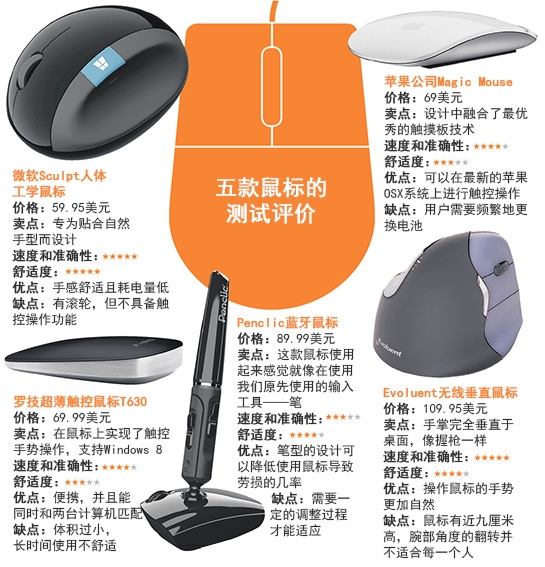
I said goodbye to my mouse last month. It was time to advance, I thought, to a higher plane of input, a trackpad that works like a tablet's screen. Instead of point and click, I'd swipe and flick.
上个月,我和自己的鼠标告了别。我原以为,是时候使用升级版的输入设备了,我指的是触控板,它的工作原理和平板电脑的屏幕类似。相较于用鼠标点击,我更倾向于在触控板上用手指扫动和轻点。
A few weeks in, I was missing my mouse. Moving a folder across a 27-inch iMac screen with the trackpad was like lugging a grand piano across the Sahara -- I had to keep taking breaks along the way, as I ran out of pad.
仅仅过了几个星期,我就怀念起我的鼠标来了。使用触控板在27英寸的iMac屏幕上移动文件夹就好像拖着一架巨大的钢琴穿越撒哈拉沙漠――我在这个过程中必须要不时地休息,因为我的触控板不够大。
This can't be progress. Determined, I rustled up a dozen of the latest input devices, regular mice and trackpads, but also vertical mice, pen- and knob-shaped mice, a touch-screen stylus, even a controller that lets you wave your hands around without touching anything, a la 'Minority Report.'
这实在谈不上进步。毅然决然地,我搜罗了十几款最新型的输入设备,其中不仅包括普通型鼠标和触控板,还包括垂直型鼠标、笔型鼠标、球型鼠标和触控笔,甚至一个不需要触摸就能感应你双手动作的控制器,感觉就像电影《少数派报告》(Minority Report)中的场景一样。
What I discovered: Thirty years after the Macintosh took the mouse mainstream, I couldn't find anything more precise or comfortable for operating a computer. More important, I found the mouse has managed to reinvent itself over the years -- it's like the Madonna of PC peripherals.
我发现:从30年前Macintosh电脑奠定鼠标方向的那一天起,直至今日,我仍然无法找到可以比鼠标更加精准和舒适地操作电脑的设备了。更重要的是,我发现,鼠标在多年中一直在不断实现创新――堪称电脑外围设备界的麦当娜(Madonna)。
One reinvention stood out during my testing, a mouse whose unconventional look belied its natural grip: the Sculpt Ergonomic Mouse by Microsoft. Other standouts I tested were Apple's Magic Mouse, the Penclic Mouse and Logitech's Ultrathin Touch Mouse.
在我的测试中,一款革命性的鼠标脱颍而出:那就是微软(Microsoft)的Sculpt人体工学鼠标(Sculpt Ergonomic Mouse)。这款鼠标外观特立独行,同时又有着自然舒适的抓握感。我测试的其他几款出类拔萃的鼠标包括:苹果公司(Apple)的Magic Mouse、Penclic鼠标和罗技(Logitech)的超薄触控鼠标(Ultrathin Touch Mouse)。
Picking a control device is kind of like choosing shoes -- some go for Air Jordans, others for Christian Louboutin heels. Everyone has their own size and physical fit -- sometimes even a medical need. (My right-handed editor swears by a trackball mouse in his left hand.)
选择操控设备就像选择鞋子一样――有些人偏好耐克空中飞人(Air Jordans)运动鞋,有些人则青睐克里斯提・鲁布托(Christian Louboutin)高跟鞋。每个人都有自己的尺码和脚形――有时候人们还要求鞋子具备医疗功能。(坐在我右手边的编辑正抱怨着他左手用着的轨迹球鼠标。)
Though PC sales have declined in recent years, mouse unit sales slipped only 3% in the past 12 months, according to industry research firm NPD. In other words, a good chunk of laptop buyers are adding mice to their productivity ensembles.
尽管最近几年PC电脑的销量有所下滑,但是据行业调查公司NPD称,在过去的12个月中,鼠标设备的销量仅下滑了3%。换句话来说,很多便携式电脑买家为提高整体效率都添置了鼠标设备。
To test my efficiency using a mouse and other input devices, I used a program scientists developed to study the speed-accuracy trade-offs in human muscle movements, called Fitts's Law. My scores, based on clicking scattered dots on a screen, were at times nearly twice as fast with a mouse as with a trackpad. Most hands are more relaxed on a mouse, so starting and stopping are easier, say the ergonomists.
为了测试我在使用鼠标和其他输入设备时的效率,我使用了一款科学家开发的用来测试人类肌肉在速度与准确性上协调程度的程序:菲茨定律(Fitts's Law)。我的得分按点击分散在屏幕上的点来计算,我使用鼠标时的得分几乎是使用触控板时得分的两倍。人体工程学家表示,大多数人的手在使用鼠标时更加放松,因此发出点击动作和终止点击动作更简单。
Of course, for flipping pages or pinching to zoom, finger gestures on a touch screen or trackpad are the more efficient way.
当然,在执行翻页或屏幕缩放的动作时,用手指在触摸屏或者触控板上进行操作更加高效。
Both Apple and Microsoft have integrated finger gestures into their latest computer operating systems. Apple sells iMacs with a trackpad option. Microsoft built the latest Windows version in the hope that users touch the screen itself.
苹果公司和微软都已经把手势控制整合到了各自最新的电脑操作系统之中。苹果公司在销售iMac电脑时提供了选择触控板的配置选项。微软在构建最新一代Windows操作系统时希望用户可以进行屏幕触控。
A touch-screen monitor on a desktop or laptop sounds good, but it invites what some call 'gorilla-arm' fatigue. After forcing myself to use only the touch screen on a Windows 8.1 laptop, I found myself propping it up at an angle in my lap so my hands could rest on the side. (Microsoft says the touch screen is meant to supplement, not replace, other inputs.)
台式电脑或笔记本电脑的触摸显示屏听起来不错,但是它会带来一种人们称作“大猩猩臂”的疲劳感。在强迫自己只使用Windows 8.1笔记本电脑的触摸屏后,我发现自己不由自主地把笔记本电脑以某个角度撑在了大腿上,这样我的手就可以搭在边上休息了。(微软表示,触摸屏的设计初衷是对其他输入工具构成补充,而并非有意取代其他输入工具。)
Then there is a problem of universality: Designers haven't yet come up with a common language for touch on computers. In Windows 8.1, a swipe from the left lets you switch between apps, while on a Mac trackpad, three fingers, moving in the same direction, open a widget dashboard. And neither movement is particularly intuitive.
除此之外,还有一个关于通用性的问题:设计师们尚未制定出电脑触屏方面的统一标准。在Windows 8.1系统中,从左向右划过屏幕可以让你在不同的应用程序间进行切换,而对于Mac触控板而言,三只手指划向同一个方向可以打开应用面板。并且,这两种动作都不是人类的自然动作。
The emerging world of touchless computing confuses things more. The Leap Motion, which tracks the movement of hands, lets you do cool tricks. But every compatible program comes with its own set of new moves you have to learn. And the accuracy of floating fingers is low. Leap Motion says its device isn't a replacement for the mouse, just an accessory for software that benefits from 3-D controls.
日渐成型的无触控电脑技术把一切变得更复杂了。能够感应手部运动的Leap Motion可以让你体会变戏法的感受。但是,每一款兼容的应用程序都需要你通过学习掌握其特定的手法。此外,Leap Motion对处于运动状态中的手指的感应灵敏度也较低。Leap Motion公司表示,这款感应设备并非鼠标的替代品,它只是3-D控制类软件的一个附件。
Mouse designers have made leaps in ergonomics. Many are now more vertical, better mimicking the posture of a hand in its natural resting state. 'Your fingers are curled into your palm, but not all evenly,' says Edie Adams, an ergonomist at Microsoft.
鼠标设计师在人体工程学上已经实现了突破。现在,很多鼠标都更加趋向于垂直型,以便更好地模拟手部在自然状态下的姿势。微软的人体工程学家伊迪・亚当斯(Edie Adams)表示:“你的手指向掌心弯曲,但并不是每根手指的角度都相同。”
My favorite mouse was one she worked on, Microsoft's wireless Sculpt Ergonomic Mouse ($60 or less). It looks like a plum, with an overly ripe area where you rest your thumb. It is comfortable enough to use for hours, the mouse equivalent of orthopedic shoes. And props to Microsoft for apparently getting it to run on one pair of AA batteries for a whole year. I'll even use it on my Mac.
我最喜欢的鼠标就是伊迪的团队研发的,即微软的无线Sculpt人体工学鼠标(售价为60美元或更低)。它看起来像是一个李子,拥有一个可以让拇指得到休息的宽敞区域。这款鼠标舒适到可以连用几个小时,堪称鼠标界的矫形鞋。这款微软鼠标还有一个明显的优势,那就是它可以依靠两节AA电池运行一整年。我甚至在我的Mac电脑上也使用它。
The runner-up was the even more vertical $90 Penclic. That familiar pen shape gave me a sense of control I wasn't expecting.
位居第二的是更具垂直性的Penclic鼠标(其售价为90美元)。这款鼠标运用了大家熟悉的笔型设计,它给我带来了意想不到的操控感。
Today's mice also do a better job at adding features through gestures, so they don't get overloaded with extra buttons. Apple's $70 Magic Mouse may be less comfortable to hold over extended periods than the ergonomic options, but it does the best job of integrating touch commands on its smooth, flat surface -- such as swiping with two fingers to advance through pages or browse photos. Logitech's $70 Ultrathin Touch Mouse puts similar gesture functionality into a body small enough to travel with a laptop.
当今的鼠标在通过感应触控手势来增加设备功能上表现得越来越出色了,所以它们不需要再设计额外的按键。与人体工学鼠标相比,苹果公司售价70美元的Magic Mouse或许长时间使用没有那么舒适,但是对于在平滑表面上感应触控指令这一点上,Magic Mouse的表现是最为出色的――比如使用双指轻扫鼠标表面,便可以浏览页面和照片。罗技公司售价70美元的超薄触控鼠标也具有类似的触控功能,这款鼠标纤巧的体积非常便于随便携式电脑一起携带。
The idea shouldn't be to try to 'out-mouse the mouse' with new kinds of inputs, says Josh Clark, a computer interface designer and founder of the firm Global Moxie. Rather, we're moving to a world of technology and input devices designed to fit specific times and places: touch screens on the go, voice activation for TVs, hand gestures to browse a store display with products.
电脑界面设计师、Global Moxie公司的创始人乔希・克拉克(Josh Clark)表示,试图用新型输入设备“取代鼠标”的理念是不正确的。我们正在进入科技和输入设备的新世界,新工具将为特定的时间和地点而设计:随处可见的触摸屏、声控电视、用手势浏览商店产品等。
I spend a growing part of my day with smartphones and tablets, but like many professionals, when I need to get work done, I'm still sitting in a chair facing a big computer screen. And there, the mouse remains king.
我在一天中使用智能手机和平板电脑的时间越来越多了,但是,与很多职业人士一样,当我需要完成工作时,我仍旧习惯坐在书桌前,面对宽大的电脑显示器。此时此刻,鼠标依然为王。


